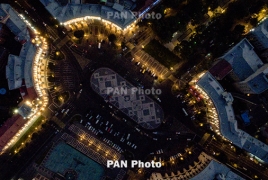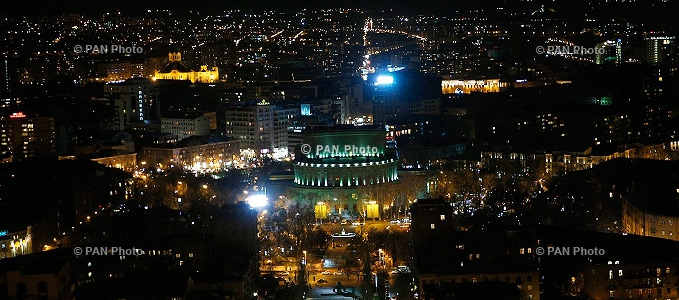
Architecture in Armenia incorporates structural works with a historical or artistic link to the Armenian nation. It is difficult to locate this architectural style within specific chronological or geographical parameters, but many of the country’s monuments were built in the historical regions of Armenia. The magnificent achievements of Armenian architecture are commonly agreed to be medieval churches; however, since the nineteenth century, the country developed more modern architecture. The Culture Trip has unveiled a guide to some of the most iconic architectural buildings in Armenia.
Armenian medieval churches
Armenian churches of different periods do have their own characteristics, so before looking at each of them separately, it’s important to know what they have in common or what unique features distinguish them from others.
The churches have pointed domes, similar to the volcanic funnel of Greater Ararat. These pointed or semi-pointed domes (cupolas) are attached above arched ceilings. The vertical accent of the whole building and its height often exceeds the length of the church. They are almost entirely made of stone either with basalt or volcanic tuff and have arched, stone ceilings. If there are carvings or Frescoes, they are usually very ornate and include intertwining foliage and grapevines.
Etchmiadzin Cathedral
Located in the city of Vagharshapat, this cathedral is a very important landmark of the Armenian Apostolic Church. The church was built in cruciform style and is considered to be one of the first and oldest cathedrals both in Armenia and the whole world. The original church was built in the early fourth century by the country’s patron Saint Gregory the Illuminator, who guided Armenia to adopt Christianity as its official religion. The core of the contemporary building was built near the end of the fifth century by Vahan Mamikonian. It was delayed due to severe damage during the Persian invasion. At first it was the seat of the catholicos, then it slowly lost its fame and became neglected over the centuries, but it never lost its significance. Additionally, the cathedral has been renovated a couple of times with belfries added in the seventeenth century, and a sacristy built in the nineteenth. Therefore, it combines styles of different periods of Armenian architecture.
The Church of Saint Gayane
This seventh century Armenian church in Vagharshapat town is within walking distance of the Etchmiadzin Cathedral. Built in 630, the design of it has not changed despite incomplete improvements of the ceilings and dome in 1652. Saint Gayane was the head of the abbey of nuns, who was persecuted with them by Tiridates III of Armenia. Later on, the Armenian Apostolic Church made her a saint. Since 2000, it has been listed as a UNESCO World Heritage Site.
Saint Hripsime Church
The town of Vagharshapat is home to another significant architectural monument of Armenia: St Hripsime Church, which is considered to be one of the oldest surviving churches in the country. Similar to St Gayane Church, this one is also dedicated to a saint who was persecuted for her belief. The building is an example of Armenian-style architecture in the classical period. It has influenced many other Armenian churches. This is also a UNESCO World Heritage Site along with Etchmaidzin Cathedral and St. Gayane Church.
Zvartnots Cathedral
Built in the seventh century, Zvarnots is a centrally framed, aisled, tetraconch cathedral. Today, all you can see are ruins located in Vagharshapat. The cathedral was built when the country was overrun by Muslim Arabs who ruled Sasanian Persia, of which Armenia was a part. The exterior, highlighting monuments, vine decorations and eagle capitals, reveal the impact of Mesopotamian and Syrian architecture.
Yererouk,also Yereruyk or Ererouk

This basilica, located near the village of Anipemza, is one of the earliest surviving Christian monuments in the country. It’s also considered to be one of the ancient examples of Armenian architecture referring to the Paleo-Christian period, around the fourth-sixth century.
Modern architectural monuments
Since being part of the Russian empire during the nineteenth century, Armenian architecture underwent a new stage of development. A number of architectural gems were built in Yerevan, and others in important cities. The buildings of that time were mainly made of basalt, so they were often black in color.
Dzitoghtsyan House-Museum of Social Life and National Architecture
Located in Gyumri, this museum was founded in 1984 in the Dzitoghtsyan family house, built in 1872. Here, you can enjoy exhibits showcasing the daily urban life of Gyumri, as well as local architecture and culture. The building was built with the famous red tuff stone of Shirak, which gives a charming look to the facade.
Kumayri Historic District
Kumayri district is part of Gyumri and features historic buildings dating back to the nineteenth and twentieth centuries. It reflects the evolution of local urban development. Covering around 1,000 hectares (2,471 acres) of land, the district is home to some 1,600 buildings and monuments representing different styles like the Neoclassical and high-rise modernist structures from the Soviet era. Marvel as you walk through the Sev Ghul fortress, a remainder of the Russo-Turkish War, and the Paris Hotel, which served as a maternity hospital during the Soviet period. Unfortunately, the hard social and political period of the 90s lead to abandonment and misuse of those historical buildings.
The Armenian National Academic Theater of Opera and Ballet

Located in the center of Yerevan, this building is an architectural masterpiece created by architect Alexander Tamanyan. In 1937 his project won the grand prize at an international exhibition in Paris. The Yerevan Opera House was constructed in the first half of the twentieth century, and today it is a cultural symbol of the country with its classical beauty, majestic stage, and imposing balconies and hallways.
Cascade Stairway and Museum
A relatively new addition to the architectural scene of Yerevan, Cascade is the capital’s most modern structure. Designed by Jim Torosyan, Sargis Gurzadyan and Aslan Mkhitaryan, the construction started in 1971 and was partially finished within nine years. Underneath the exterior steps, there are seven escalators rising along the lengths of the complex. It features various exhibition halls, including the Cafesjian Museum of Art. The exterior highlights multiple levels of decorative fountains and contemporary sculptures from the Cafesjian collection. Feel free to walk up the stairs and enjoy beautiful views of Yerevan’s center.
Republic Square
Republic Square is another example of modern architecture in Armenia. The square consists of two sections: an elliptical roundabout and a trapezoid-shaped pool with musical fountains. The square is enclosed by five major buildings constructed with yellow and pink tuff stone in the neoclassical style with the extended use of Armenian motifs.

